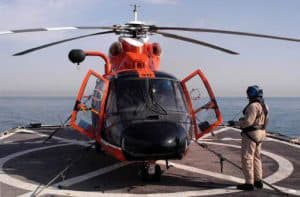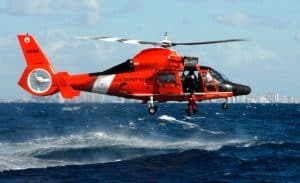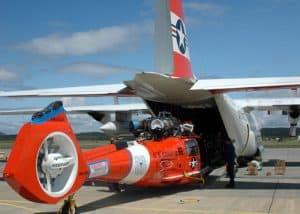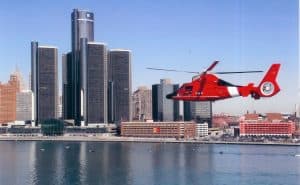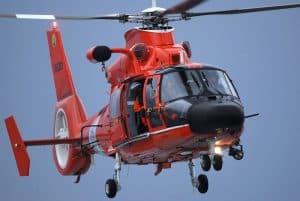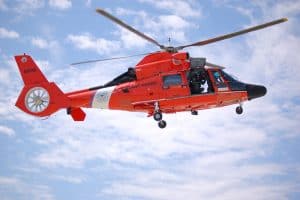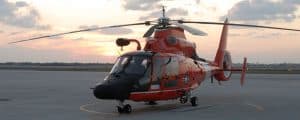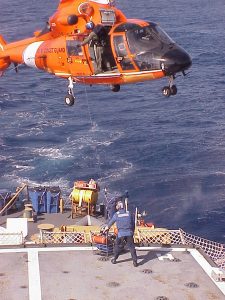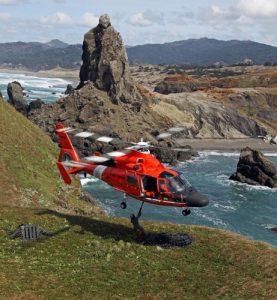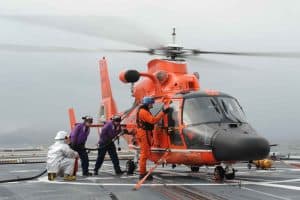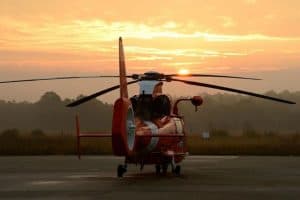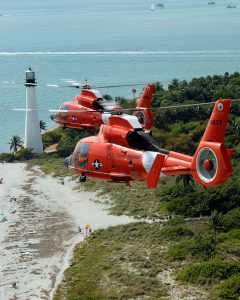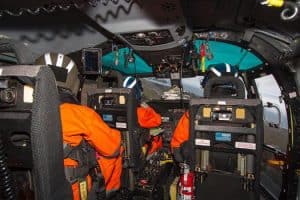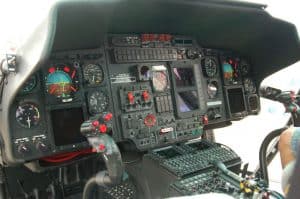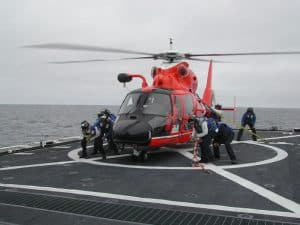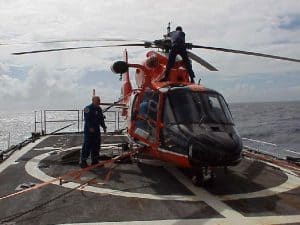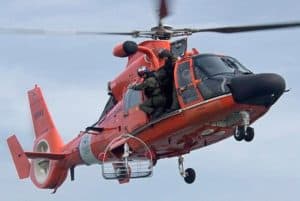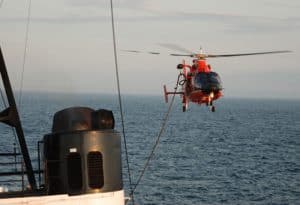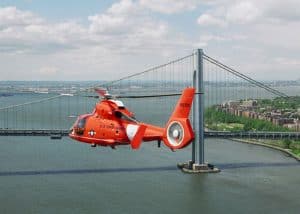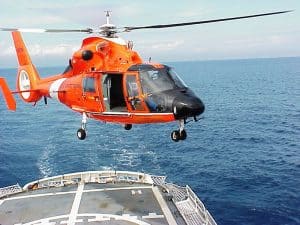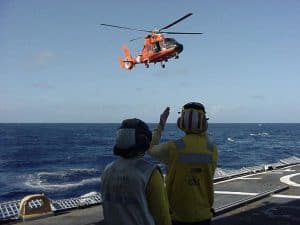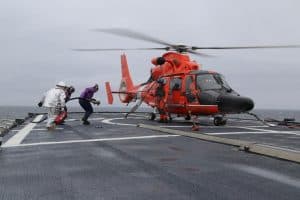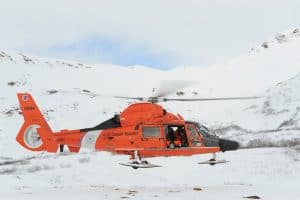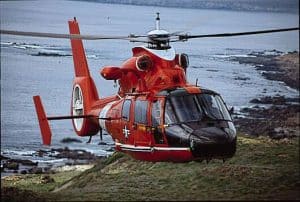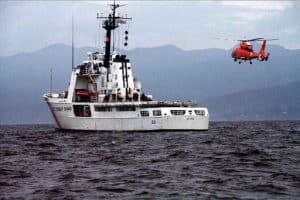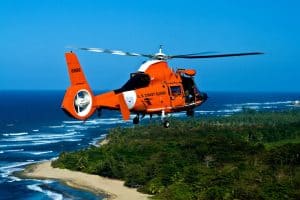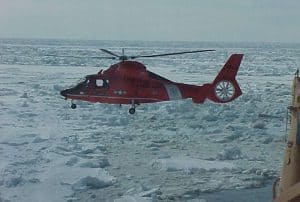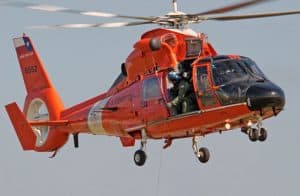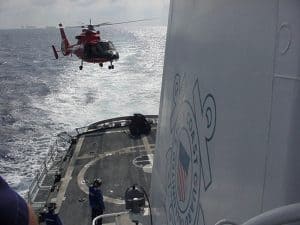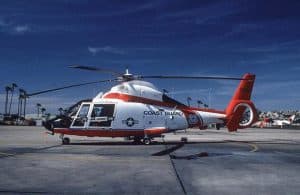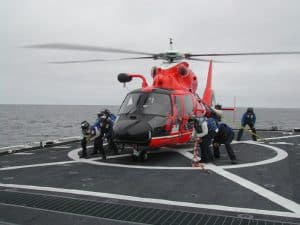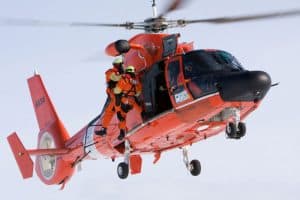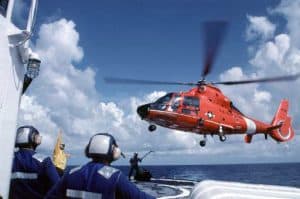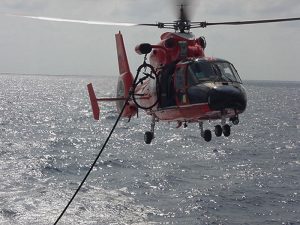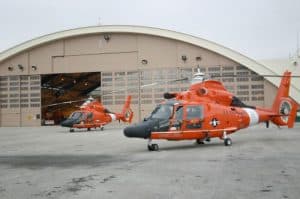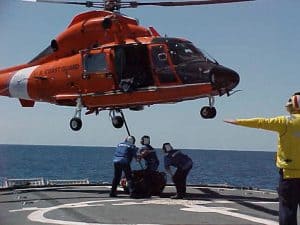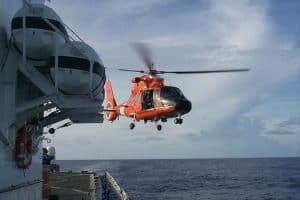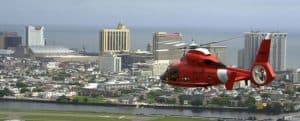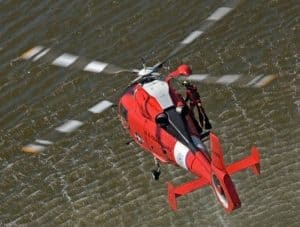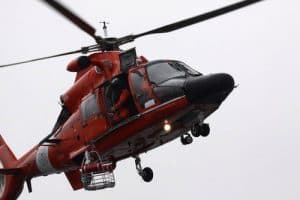By Sperry Storm, CAPT USCG (ret.)
Foreward
By John Moseley, CGAA Historian
Often the Coast Guard has been able to acquire and utilize aircraft already in production to fulfill the needs of the service. There are occasions, especially in recent times, where in order to effectively carry out its mission, the Coast Guard has had to select a basic production airframe and modify and rework it. This was the case with the HH52 helicopter and the HH-65 helicopter that replaced it.
Captain Sperry Storm USCG (ret). was Commanding Officer of the HH-65 Air Program Office (APO) 1985 – 1988. The APO provided administration and oversight to ensure that the helicopter met specifications and was delivered to operating units as per the contract. He has written an outstanding detailed narrative of the process that began with the initial aircraft requirements and takes us through the selection and testing procedures up to the acceptance of the HH- 65. Captain Storm has drawn on his own experience and that of the other principals involved in the HH-65 project.
The HH-65 has proven to be an outstanding asset. Designated a Short Range Recovery helicopter (SRR) it operates from both Air Stations and Coast Guard Cutters. It performs rescue operations and is used extensively in the drug interdiction program operating from Coast Guard Cutters. Its composite structure greatly reduces the corrosion problem. It is equipped for use of force where and when necessary. The Coast Guard has enhanced the MH65 through a series of incremental upgrades to meet increasing mission requirements. The service life has now been extended to 2027.
The HH-65 helicopter is a testament to the professional knowledge, skill, and dedication of those that brought the HH-65 on board.
Genesis of the Coast Guard’s HH-65 Aircraft
By Sperry Storm, CAPT USCG (ret.)
Planning
In the summer of 1974, recognizing that the venerable HH-52 fleet would require replacement in a few years, the Commandant established the Short-Range Recovery (SRR) Aircraft Characteristics Board (ACB). The members were: CAPT Chuck Larkin, CDR Howie Thorsen, CDR Bob Watterson, LCDR Don Aites, and LCDR Pete Poulos. The ACB researched then current small helicopters, including attending the Farnborough Air Show in England. After considering the historical performance of the H-52, the ACB developed a list of seventeen characteristics necessary to meet required mission performance:
1. Radius of action: 150 nautical miles (nm); 30 minutes on station, with fuel reserve
2. Range: 400 nm
3. Minimum cruising speed: 100 knots
4. Endurance: 3.5 hours, plus reserve
5. Rescue capability: 3 persons at max radius of action
6. Litter capacity: required
7. Rescue hoist: 600-lb. capacity
8. Passenger capacity: 6
9. Power plant: twin turbine engines
10. Operating environment: all-weather maritime, semitropical to arctic
11. Flight controls: dual
12. Avionics: navigation/communication/detection
13. Size: operate from flight deck-equipped Coast Guard cutters; fit two in icebreaker hangars
14. Weight: 10,000 lbs. max
15. Shipboard maintainability: as required for program
16. Fueling: gravity and pressure
17. Cargo sling: 2,000-lb. capacity
The justification for each stand-alone item presented a challenge. After various efforts proved inadequate, the ACB concluded that several scenarios, based on actual HH-52 flights, would collectively justify all seventeen, in order to accomplish the missions.
During a briefing for the Commandant, Vice Commandant, and Chief of Operations in May 1975, the ACB showed the characteristics to be appropriate for one or more of the regular missions being flown, and all were immediately approved. Having a Commandant-approved list proved to be greatly beneficial during the steps leading to the acquisition process: when others attempted to add additional requirements, the proposer would be informed that any additions would require approval by the Commandant…and there were none.
Candidates
In the summer of 1977, the go-ahead was given, and the SRR Source Selection Advisory Committee (SSAC) was formed, under then-CAPT Howie Thorsen, who was reporting for duty as G-EAE after graduating from The Industrial College of the Armed Forces. He was designated the SRR Project Officer and led a small team consisting of CDR Jim Butler, LCDR Dave Young, LCDR Dave Jones, LCDR Jim Szymanski, and CWO4 Lowell Andrews. The first order of business was to draft the Request for Proposals (RFP). Acknowledging the magnitude of the task and the lack of in-house expertise, the Coast Guard requested the assistance of the Naval Air Systems Command (NAVAIR), not only for advice in preparing the RFP but also to provide an independent evaluation of all candidate helicopters. With
extraordinary cooperation and an eagerness to help, the most highly regarded civilian in NAVAIR, Mr. George Spangenberg, lent his personal support. NAVAIR established a Coast Guard office; formed an SRR ‘Class Desk’; and supported the SRR program in the same manner as any Navy/Marine aviation acquisition program.
The RFP was issued in September of 1977, with a Coast Guard decision on the new helicopter planned for August of 1978. Offerors were required to have an actual flying, certified helicopter as a ‘base’ design. Three companies responded to the request: Textron Bell Helicopter, with a utility version of its Model 222; Sikorsky Aircraft, with a version of its S-76 Spirit; and Aerospatiale Helicopter Corporation (AHC), with a modified version of its SA365C. Through NAVAIR, the Coast Guard worked with the U. S. Naval Air Test Center Patuxent River, Maryland (NATC), to conduct limited quantitative flight evaluations on the aircraft the bidders made available. Additionally, the Coast Guard conducted separate qualitative flight evaluations. Each aircraft was instrumented for a variety of flight/handling parameters and had assigned NATC and Coast Guard teams. The NATC evaluations were completed in 15 flight hours for each aircraft, and their reports suggested additional specification requirements. The Coast Guard teams conducted shorter qualitative evaluations of five flight hours each. The Coast Guard teams were: Bell 222, LCDR Don Wittschiebe; SA365C, LCDR Tom McLaughlin; S-76, LT Joel Thuma. LCDR Jim Szymanski and CWO2 John Reid participated in all Coast Guard flights of each aircraft. CAPT Howie Thorsen and CDR Jim Butler flew each of the candidates for familiarization purposes.
The SSAC ultimately found that all three candidate aircraft met the RFP specifications, to varying degrees. The Sikorsky S-76 was rated the overall best qualified machine, primarily because of its large cabin space; the Aerospatiale 365C handily met all requirements; while the Bell 222 was marginal in several aspects. The Coast Guard’s long experience and nearly exclusive working relationship with Sikorsky Aircraft added to a feeling that the next SRR helo might continue to carry the Sikorsky brand.
Bids
The last step in the formal acquisition process would be the ‘best and final’ submission by each manufacturer, showing their final bids. Although it was a ‘best value’ not a ‘low bidder wins contract, price was assumed to be a heavily weighted factor—the other two being the candidate aircraft evaluation results and the established history of credible business practices by the manufacturer.
The percentage weight of these three factors had been established by a Source SelectionAdvisory Board (SSAB) that had been established by the Secretary of Transportation in the approval of the acquisition process. The board consisted of three members: one from the CoastGuard (RADM Ben Stabile, Chief Office of Engineering); one from the Navy (RADM George E. Jessen from NAVAIR, an experienced naval aviator with a background as the S-3 aircraft program manager); and one from the Department of Transportation (a civilian). That board had met early in the process to determine the specific percentages that would attach to each of the three factors. They then sealed the result, which would remain unknown and unannounced until after the final presentation of the evaluation results and the ‘best and final letters’ by the SSAC to the SSAB. Ultimately, after applying the weights, the SSAB ranking of the offers would be presented to the Designated Decision Authority (DDA), the Deputy Secretary of Transportation. The delivery of the ‘best and final’ letters would mark the culmination of all the work and efforts of the SSAC, NAVAIR, and many others whose sole mission had been to identify the best helicopter for future Coast Guard pilots and crewmen. The exact time and place for delivery of the letters was announced by the SRR Contracting Officer, Mr. A. J. Beard, several weeks before the date; late submittals would not be allowed. Understandably, everyone involved felt great anticipation on the appointed date.
The Bell and Aerospatiale letters contained their final bid prices. Sikorsky’s letter had no pricing information; it merely stated that it was terminating participation in the SRR competition. The news of Sikorsky’s withdrawal was a shock, not only to the Coast Guard but to the aviation industry. The SRR program would be the largest Coast Guard aviation procurement to date, considering not only the original delivery of 90 helicopters but also the included spare parts and logistic support. The selection of the Coast Guard’s future short-range helo would be a major endorsement of the selected helo for many years, both nationally and internationally. (On another historical note, we later learned that Pierre Marion, chairman of AHC and the Aerospatiale representative in Washington, D.C., was so impressed with the RFP that he directed Mr. Jake Benner, president of AHC, to reduce the proposal price by the one million dollars that had been reserved for contingencies. In so doing, the AHC price became just a few dollars less than the Bell price. Not that it would have made a difference in the final selection, but it removed almost anything that could have favored Bell.) Sikorsky made the decision to withdraw at the last possible minute. The emissary who flew to Washington from Connecticut that day had two letters in his suit coat, with orders to proceed to the lobby of the HQ building at Seventh Avenue and D Street. He was then to call Mr. Jerry Tobias, president of Sikorsky Aircraft, at his office in Connecticut, who would instruct him which letter to submit. The other letter was their ‘best and final’ offer.
(Years later, we learned that Sikorsky’s decision to withdraw was based on its business forecast. It anticipated a large increase in offshore drilling worldwide, providing a huge market for the S-76, which had been designed for the express purpose of carrying ten oil rig crewmembers to and from land—thus the large cabin space. Anticipating a very large number of helos to be produced for the commercial market during the same years the Coast Guard would require a significant delivery rate of the SRR, and considering the production line capacity and the lesser profit margin dictated by the SRR competition, the business case argued for the company’s withdrawal. Unfortunately for Sikorsky, the expected boom in offshore drilling did not materialize for many years.)
Award
In any case, both remaining competitors’ helos had been evaluated as acceptable, so the acquisition process could proceed. With all acquisition activity completed, the SSAC briefed the SSAB, and the briefing for the Deputy Secretary of Transportation (the DDA) was scheduled for 14 June 1979. The briefing material was prepared for presentation by Mr. Spangenberg, the most knowledgeable acquisition person involved. On that date, the members of the SSAC and SSAB assembled. However, they then received word that the DDA was running late and would have only ten minutes available for the briefing. After a quick shuffle of the PowerPoint slides, Mr. Spangenberg was ready when the DDA arrived. The briefing went without a hitch, the SSAB affirmed the members’ findings, and the session ended—without any indication by the DDA which aircraft would be selected for contract award. But later that afternoon, the Department released the news that Aerospatiale had been awarded the contract. Everyone felt a huge relief that our job was completed and the best available helo had been selected.
The SSAC disbanded. Every member, with one exception, was under orders to a new assignment, most affiliated with the SRR Aircraft Program Office (APO). CDR Jim Butler went to command Air Station Port Angeles and CAPT Howie Thorsen continued his duties as Chief of Aeronautical Engineering, with the SRR project now underway and expected to be much less time-consuming. The only remaining task was to brief Bell Helicopter, as requested, on the results of the evaluation of their candidate—without releasing the evaluation results for either of the other two helos. Howie gave the briefing two weeks later. The only comment from the Bell group at that time was that they thought the Coast Guard had been generous in evaluating several areas of performance.
Objection!
However, within a few weeks, Bell filed a protest with the Government Accounting Office (GAO) and filed suit in federal district court, seeking to block any Coast Guard action to proceed under the terms of the contract. In a rather short time, GAO ruled in the Coast Guard’s favor. The lawsuit would not be settled in the near term, but there was no delay or change by the Coast Guard in proceeding to acquire the helicopters.
Despite the fact that this was a ‘best value’ not a ‘low bid’ contract, Bell’s lawsuit aimed to disqualify the Aerospatiale bid. The basis for Bell’s challenge was that the Aerospatiale helo did not meet the provisions of the Buy America Act. Bell maintained that the determination of the ‘effective’ pricing should have been raised and incorporated for consideration in the final bid. The operative term was ‘domestic end product.’ Was a sufficient portion of the helicopter (based on total cost) considered to be an American product (either produced or assembled in the U.S.), making it a ‘domestic end product’? If so, the provisions of the Buy America Act would be satisfied.
The Justice Department (DOJ) assigned a lawyer to the Coast Guard, and the Bell suit was adjudicated in the federal district court in the District of Colombia. The relationship between CAPT Thorsen and the DOJ attorney was not smooth. Communications were infrequent— months would pass with no activity. Then, on very short notice—24 hours or less—the attorney would need information provided to meet an about-to-occur deadline; a legal statement or explanation of specifications or processes would have to be prepared and presented to the court. At that point, Howie was expected to drop all his other responsibilities, despite the fact that he was also the project officer for the Falcon acquisition; there was an APO in Little Rock for the Falcon program; and FAA certification of the Garrett ATF3-6 engine was not going well—not to mention the normal EAE business involving current aircraft.
After more than 12 months, on 8 May 1980, the court heard oral arguments. The judge, Joyce Hens Green, ruled in favor of the Coast Guard on 30 May. The last challenge to the SRR contract had ended. Eighteen days later, Howie departed for his next assignment and Captain Bob Johanson soon assumed the position of G-EAE.
Production and Approvals
The Coast Guard contract specifications reflected very ambitious schedules. The helicopter was to be U.S. FAA-certified under Part 27, which had to be coordinated with the French FAA (DGAC). Each airframe was assembled for initial certification purposes at Aerospatiale Division Helicopter (A/DH) in France using certain ‘slave’ equipment such as engines, main gear box, and other equipment supplied by AHC in Texas. After the helo was flown in France to satisfy A/DH and DGAC, it was partially disassembled for shipment, and the ‘slave’ equipment removed to be used on each subsequent airframe.
Although the airframe was a derivative of the basic Sud Aviation SA365A, it was considered a new airframe, and thus required a Type Certificate (TC). The Lycoming LTS-101 engine, replacing the AS365 Turbomeca Arriel engine, was a tried-and-true power source for many fixed-wing airplanes, but was new to the helo and therefore also needed its own TC. The AHC aircraft, now designated SA366G, was considerably smaller than the HH-52 it was to replace, so space for all equipment was at a premium. The Coast Guard provided an avionics specification detailing the capabilities, and in many cases the exact equipment to be used. The helicopter was to be certified for single-pilot instrument flight rules (IFR) flight and be the first helicopter so certified with a four-axis autopilot.
The Aircraft Program Office (APO) for the SRR contract was established soon after the contract was awarded in 1979. CDR Dave Young was the first commanding officer. Subsequent COs were CDRs Don Wittschiebe, Sperry Storm, and Bud Tardiff. The APO was structured like the first Coast Guard APO in Little Rock, Arkansas, for the MRS HU25 Falcon program. The APO provided support for administering the contract with a civilian contracting officer,
Mr. George Lowe, and clerical staff, in addition to pilots and aircrew personnel. Like other APOs, the organization was similar to that found at Coast Guard air stations (CO, XO, OPS, EO, ADMIN), with an independent contracting officer reporting separately to the Headquarters acquisition staff. The APO performed the duties of the contracting officer’s technical representative (COTR); therefore, all correspondence and formal communication with contractors went through the contracting officer.
AHC’s original facilities were located at the facilities of Vought Helicopter Corporation, which operated for a short period as a licensee of A/DH. In 1979, AHC built its own plant facilities in Grand Prairie, Texas. These facilities provided the APO with dedicated space. The assigned personnel were involved from the beginning, attending not only the formal program reviews but also visiting A/DH in France, Lycoming in Williamsport, Pennsylvania, Rockwell Collins in Cedar Rapids, Iowa, the FAA lead region for helicopter certification in Ft. Worth, Texas, and the FAA Lead Region for Engine Certification in Boston, Massachusetts. The formal reviews consisted of a post-award meeting, a Preliminary Design Review, a Critical Design Review, and monthly program/progress reviews.
Testing and Evaluation
In an effort to gain early Coast Guard approval of the proposed configuration, AHC fabricated a full-sized mockup for use at the Critical Design Review. The cockpit was fairly well designed but underwent modifications based on inputs received during reviews at Rockwell Collins and the Preliminary Design Review. In addition, crew members used various equipment (litter, rescue basket, trail line, float lights, pumps) to work through the necessary cabin operation scenarios. The interface between the hoist operator and his various controls received considerable input that was incorporated into the final configuration. The use of the mockup enabled the contractor and major vendors to rapidly move out with prototype builds.
Three helicopters were used in flight tests. Two were flown to obtain DGAC certification in France, then, through reciprocity, the U. S. FAA certification. The third was used in the United States to prove the avionics installation. Eventually, all three were flown out of Grand Prairie. As the program progressed, in accordance with the contract, APO personnel became involved in component development, testing, and conformity to specification as the aircraft went down the production line. As required by the contract, the APO conducted acceptance inspections and acceptance flights. The APO was responsible for developing maintenance procedures using data that was deliverable under the contract. Additionally, the APO took the lead in managing the minimum stocking list for the initial spares for each air station before the helos became operational. Under the contract, the APO managed the initial training of maintenance personnel, provided by AHC at the Grand Prairie facility.
Contentions
During test and acceptance, the APO identified many major and minor problems that AHC corrected before acceptance. Aspects of the early production aircraft determined to be noncompliant with minimum contract specifications were:
– The aircraft’s in-hover sideward flight maneuvers
– The engine compressors (they stalled in snow)
– Avionics cooling
– Interchangeability of parts between aircraft
– The radar altimeter (it cycled in coupled hover over water)
Correction of these problems as well as others involved contractual disputes. These resulted in claims and counterclaims, which eventually resulted in a negotiated settlement. The settlement included tradeoffs that resulted in an increase from 90 to 96 delivered helicopters; adjustments to delivery schedules; and payment of costs for improvements required to meet the specifications. The Coast Guard accepted the first of 96 HH-65s for service on 14 November
1984.
The APO remained on site during production and acceptance, until after the acceptance of the last aircraft in 1989. A separate office known as the Special Projects Office was located nearby. It was staffed by government attorneys and selected technical staff, led initially by CDR Don Wittschiebe, and included the original civilian contracting officer, Mr. George Lowe. This was done to permit litigation to proceed without interfering with day-to-day APO and AHC operations.
The major fault following the aircraft into operation was the engine. The aircraft had a basic gross weight almost 600 pounds heavier than predicted in the specification. The longevity of the LTS 101-750 engine was compromised by poor manufacturing tolerances and component material problems. This combination resulted in an underpowered aircraft.
Separate from other contract issues, the Coast Guard began investigating engine performance deficiencies. It was contemplating a contract claim against AHC as prime contractor. However, before the claim was fully defined, reduced to writing, and put in final format, an employee of AHC filed a ‘whistleblower’ Qui Tam suit against Lycoming. As a result of this action, the DOJ assumed the lead for all engine-related problems, with the Coast Guard providing the technical expertise at negotiations.
This lawsuit had little to nothing to do with the engine performance but was instead based on the delivery of engines with improperly manufactured components having metallurgical defects, as well as deficient documentation. Although the prototype LTS-101-750 A1 engines had performed flawlessly during all FAA certification tests, as witnessed by Coast Guard, FAA, and Lycoming representatives, the production version of the engine had minimal performance margins, which were depleted in a matter of tens rather than hundreds or thousands of hours. A powerful argument in the Qui Tam suit was Coast Guard evidence that the engine gas producer (GP) turbine blades were ‘unwrapping’, that is, changing the angle of incidence to the gas flow path when exposed to normal operating temperatures. As the blades unwrapped, the efficiency of the GP turbine decreased. Since the USCG Aircraft Repair & Supply Center (AR&SC) was re-blading GP modules, it had a collection of over 1500 GP blades. The AR&SC team measured the angle of incidence of each removed blade, recorded the time installed for each blade, and graphed the blade unwrap versus time. This data provided a predictable correlation between GP blade operating hours and amount of blade unwrap. The greater the unwrap, the less efficient the GP blade, and thus the GP module, became. Lycoming made an
argument about the confidence factor of the sample, but court testimony established that the data came from the entire population, rather than a sample, so the judge agreed that the confidence factor of the data was 100 percent. This was a major factor in the government’s case.
Another factor was that the power turbine (PT) wheel, a blisk with the wheel and blades cast as a single unit, experienced cracks at the blade-to-turbine wheel interface because of unequal cooling during manufacture, causing PT blades to separate during operation, resulting in engine failures. This defect was very easy to prove, which added another big bonus to the government’s claim for compensation.
The attorney DOJ assigned to pursue this case was very junior, but took on the challenge with passion and energy, and was a very quick study concerning the technical issues involved. These were significant factors in the success of this litigation. The result was that Lycoming was required to provide a six-year Power-by the-Hour Overhaul and Service Agreement to the Coast Guard and a monetary settlement to the U.S. government of $17 million. The final settlement on the ‘whistleblower’ Qui Tam suit was the largest Qui Tam recorded at that time. The Coast Guard eventually replaced the LTS 101-750 engine with the more powerful Turbomeca Arriel 2C2-CG. The HH-65 underwent a service life extension and became the Multi-Mission Cutter Helicopter (MCH).
Summary of HH-65 helicopter models
- HH-65A: Initial USCG version.
- HH-65B: Avionics upgrade was undertaken on a portion of the fleet. Retrofit included a night vision goggle (NVG)-compatible integrated flight management avionics suite. The HH-65B upgrade was undertaken at the Coast Guard’s Aircraft Repair and Supply Center (ARSC) in Elizabeth City, NC, with the first aircraft rolling off the programmed depot maintenance (PDM) line in March 2001.
- HH-65C: HH-65A/B upgraded with new Arriel engines that provided 40 percent more power and higher performance, plus an upgraded tail gearbox and long-nose avionics compartment. First retrofit completed in October 2004.
- MH-65C: Initially intended only for use by the MCH, a further enhancement of the HH-65C within the USCG Deepwater effort. Included a 10-blade low-noise Fenestron, relocated avionics, and an airborne use-of-force package (in common with that of the modernized HH- 60T) that provided the capability to fire warning and disabling shots from the air. The MH-65C designation is now also applied to HH-65Cs used in “airborne use of force” missions, such as the Helicopter Interdiction Tactical Squadron (HITRON) mission taken up by the MH-65C in early 2008. The HITRON aircraft are armed with the Barrett M107CQ 12.7 mm anti-materiel rifle and M240G 7.62 mm machine gun. Note: the 10-blade tail rotor was not unique to the MH-65C change. The addition of the 10-blade tail rotor became necessary because the older tail rotor blades became obsolescent.
- MH-65D: MH-65C with an upgraded flight navigation system common to Department of Defense helicopters. The first production MH-65D was completed on 20 January 2011. It is fitted with a Honeywell HG7502 radar altimeter, two Honeywell H764G EGIs (embedded GPS/inertial navigation systems), and two control display units CDU-7000D from Rockwell Collins. All H-65s will be upgraded to MH-65D standard, with a target completion date of 2015.
- MH-65E: The MH-65E will incorporate upgrades that will modernize the cockpit by installing digital ‘glass’ cockpit instruments, known as the Common Avionics Architecture System (CAAS), similar to those installed in the Coast Guard’s upgraded MH-60T Jayhawk Medium Range Recovery (MRR) helicopters. The Echo upgrade will also replace the legacy analog automatic flight control with a digital system and install a digital weather radar system. The MH-65E model is expected to begin delivery to the fleet in FY 2015. The Coast Guard is planning projects to extend the useful life of the HH-65 until 2027.
Acknowledgments
My sincere thank you to the following for their assistance in making this paper possible:
VADM Howard Thorsen USCG (ret.)
RADM Robert Johanson USCG (ret.)
CAPT Rob Ayer USCG (ret.) Editor
CAPT Paul Garrity USCG (ret.)
CDR Jim Szymanski USCG (ret.) (The first H-65 Aircraft Commander)
CDR Dave Young USCG (ret.)
CWO Richard Smallwood USCG (ret.),
Mr. George Lowe, Coast Guard Contracting Officer (ret.).


